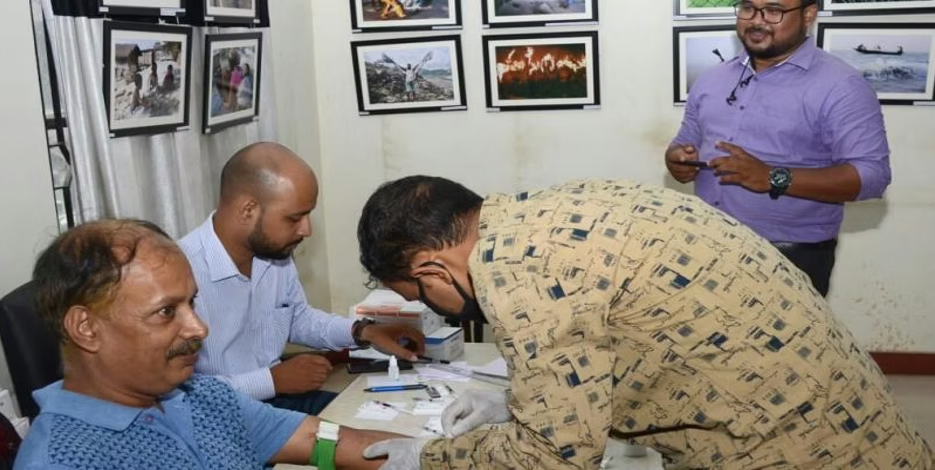India’s Health Crisis: Lifestyle Diseases Surge Amid Persistent Infections
- Rachelle DiMedia
- Aug 21
- 4 min read

India is facing a dual health crisis. A disproportionately high number of noncommunicable diseases (NCDs), mainly cardiovascular disease, COPD, diabetes, and cancers, now account for 63% of all deaths. Sedentary lifestyles, poor diet, tobacco use, pollution, and limited access to care have fueled this surge, hitting the poorest states the hardest 2.
Simultaneously, infectious diseases like tuberculosis, along with mosquito-borne illnesses, continue to claim thousands of lives, revealing the country’s gaps in the public health system6.
Together, these combined challenges emphasize the fragility of the country’s healthcare resources and regional inequalities across its states. There is a growing need for increased investment in inclusive prevention and treatment.
Heart Disease, COPD, Cancer, and Diabetes
Cardiovascular disease and COPD are now the leading killers in India, affecting people 5 to 10 years earlier than in wealthier nations2.
Oral cancer is most common in men, while cervical, breast, and uterine cancers dominate in women. Greater prevention campaigns and affordable screening programs are needed urgently to reduce its toll 2,10.
Diabetes has emerged as a silent epidemic, with rates far higher than previously estimated. While cases are stabilizing in some developed states, poorer regions continue to see steep increases. Without targeted interventions, diabetes could overwhelm India’s healthcare framework in the coming decades3.
Tuberculosis and Mosquito-Borne Diseases
Despite medical advances and a decrease in incidence, tuberculosis (TB) remains one of India’s major health challenges. India accounts for 26% of global TB cases, the highest worldwide. Although efforts are underway to eliminate TB, issues like malnutrition, poverty, and overcrowding—especially in slums—pose significant obstacles in a densely populated country⁴,5.
Mosquito-borne diseases such as dengue, malaria, and chikungunya remain endemic. Climate change, urban crowding, pollution, and poor sanitation contribute to recurring outbreaks that strain local healthcare resources6.
Sickle Cell Disease: A Neglected Crisis
Sickle cell disease (SCD) largely affects tribal and rural populations, and India bears the second-largest global burden of SCD. Overall survival is 2-3 decades shorter than the average population, and this number may be higher in tribal populations where deaths go unreported7,8.
In 2023, the government launched the National Sickle Cell Anemia Elimination Mission, targeting eradication of the disease by 2047 through early screening, genetic counseling, and improved access to hydroxyurea therapy.7
Mental Health
Mental health disorders impact one in seven Indians. This, combined with NCDs, is creating a significant burden on the healthcare system. Evidence shows that mental disorders are precursors to a variety of NCDs. Raising awareness and boosting efforts to address the mental health crisis are essential.
Looking Ahead
India’s health challenges mirror the intersection of modern lifestyles, regional disparities, and ongoing infectious threats. Experts emphasize the need for greater investment in prevention, better screening, expanded treatment options, and universal access. While government programs have made progress, without more comprehensive public health strategies, NCDs and infections will continue to claim millions of lives. India cannot afford to wait; the country's health is at stake.
Author: Rachelle DiMedia
References
HealthData.org. “Health by Location: Disease Burden Initiative India.” Accessed Aug. 20, 2025. https://www.healthdata.org/research-analysis/health-by-location/disease-burden-initiative-india
Stanford Asian Health Institute. “India Data Brief: Cardiovascular Disease.” Accessed Aug. 20, 2025. https://asianhealth.stanford.edu/sites/g/files/sbiybj30391/files/media/file/india-data-brief.pdf
Anjana, Ranjit Mohan, Ranjit Unnikrishnan, Mohan Deepa, Rajendra Pradeepa, Nikhil Tandon, Ashok Kumar Das, Shashank Joshi, et al. “Metabolic Non-Communicable Disease Health Report of India: The ICMR-INDIAB National Cross-Sectional Study (ICMR-INDIAB-17).” Diabetes & Endocrinology, vol. 11, 2023, pp. 474–489. Published online June 7, 2023. https://doi.org/10.1016/S2213-8587(23)00119-5
World Health Organization. Global Tuberculosis Report 2024. Geneva: World Health Organization; 2024. https://www.who.int/teams/global-programme-on-tuberculosis-and-lung-health/tb-reports/global-tuberculosis-report-2024/tb-disease-burden/1-1-tb-incidence?utm_source=chatgpt.com
Prasad R, Singh A, Gupta N. Tuberculosis and COVID-19 in India: Challenges and opportunities. Lung India. 2020 Jul-Aug;37(4):292-294. doi: 10.4103/lungindia.lungindia_260_20. PMID: 32643635; PMCID: PMC7507925.
Times of India. “Rise in Dengue Cases Fueled by Climate Change, Globalization.” Accessed Aug. 20, 2025. https://timesofindia.indiatimes.com/city/patna/world-mosquito-day-rise-in-dengue-cases-fuelled-by-climate-change-globalisation/articleshow/123389687.cms
Jain D, Gupta M, Madkaikar M, Jena RK, Khargekar N, Saraf SL, Krishnamurti L, Gupta K. Sickle cell disease in India: current status and progress. Lancet Haematol. 2024 May;11(5):e322-e323. doi: 10.1016/S2352-3026(24)00109-1. PMID: 38701819.
Kumar A and Bhattacharya S (2024) Sickle cell disease: a comparative perspective on global and national initiatives. Front. Hematol. 3:1457158. doi: 10.3389/frhem.2024.1457158
Insights Editor. (2025, January 25). UPSC: Editorial analysis: Sickle cell disease in India: A public health challenge. Insights on India.
Times of India. “Oral Cancer Rising in Younger Adults.” Accessed Aug. 20, 2025. https://timesofindia.indiatimes.com/life-style/health-fitness/health-news/oral-cancer-rising-in-younger-adults-causes-early-warning-signs-smokeless-tobacco-risks-and-prevention-tips/articleshow/123407865.cms
Gururaj G., Varghese M., Benegal V., Rao G. N., Pathak K., Singh L. K., Mehta R. Y., Ram D., Shibukumar T. M., Kokane A., Lenin Singh R. K., Chavan B. S., Sharma P., Ramasubramanian C., Dalal P. K., Saha P. K., Deuri S. P., Giri A. K., Kavishvar A. B., Sinha V. K., Thavody J., Chatterji R., NMHS collaborators group. National Mental Health Survey of India, 2015–16: Summary. Bengaluru: National Institute of Mental Health and Neuro Sciences; 2016. ISBN 81-86477-00-X.
Public Health Foundation of India. “First comprehensive estimates of disease burden due to mental disorders and their trends in every state of India.” PHFI website. December 23, 2019. https://phfi.org/disease-burden-due-to-mental-disorders-and-their-trends-in-every-state-of-india/?utm_source=chatgpt.com



Comments